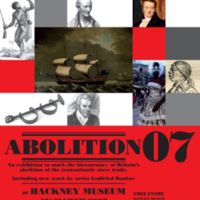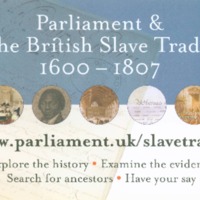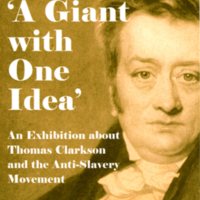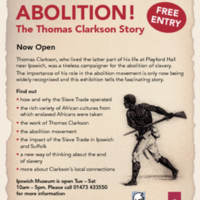
Abolition 07
Hackney Museum's Abolition 07 exhibition told the story of British involvement in the transatlantic slave trade, the resistance to it, and its abolition, and in particular emphasised the involvement of Hackney's residents in the abolition movement. The display included new artwork by Godfried Donkor in collaboration with young Hackney artists. A film of interviews with Hackney residents, Hear My Voice, was produced. Over 1200 children from Hackney Primary Schools took part in poetry workshops at the museum with poets Adisa and Baden Prince. Their poems and responses were published in the booklet 'And Still I Rise'.
The research into Hackney's connections to the transatlantic slave trade continued in 2013-2015 with 'Local Roots / Global Routes', a collaborative project between Hackney Museum and Archives and the Legacies of British Slave-ownership project.

The British Slave Trade: Abolition, Parliament and People
This exhibition in Westminster Hall told the story of the pressures and events, at home and abroad, which influenced Parliament's abolition of the British slave trade in 1807. The Act itself was displayed alongside petitions sent to Parliament by the public. Also on display was Thomas Clarkson's African Box, used on his abolition tours.
As part of the wider project, the Parliamentary Education Service appointed poet and writer Rommi Smith as Parliamentary Writer in Residence to the exhibition. In a series of workshops, Rommi worked with secondary school pupils to explore the historical, social and emotional issues around the transatlantic slave trade in poetry and prose. This included letters and statements that they would have sent to the prime minister of the time, to Olaudah Equiano and other key figures. To mark the UNESCO International Day for the Remembrance of the Slave Trade and its Abolition on 23 August 2007, the Parliamentary Education Unit asked people to submit squares for a commemorative quilt. Some of these designs are available to view on the Parliamentary Archives website, which also uses original source material to tell the story of Parliament's complex relationship with the British slave trade.

'A Giant with One Idea': An Exhibition about Thomas Clarkson and the Anti-Slavery Movement
A Giant with One Idea told the story of the anti-slavery campaign through the personal narrative of the abolitionist Thomas Clarkson, who was born and raised in Wisbech. The exhibition included an overview of the transatlantic slave trade, major campaigners in the abolition movement, the antislavery campaign after 1807, and details of Clarkson’s travelling chest, which he used to help illustrate the cruelty of the slave trade. The exhibition later travelled to other venues in the area. Accompanying the exhibition was a handling box based on Clarkson’s chest available for schools and community groups, as well as a children’s activity booklet led by the character of Clarkson himself. The museum also supported the publication of a number of books telling the life stories of Thomas Clarkson, and his less well known brother, the naval officer John Clarkson.

Abolition! The Thomas Clarkson Story
Colchester and Ipswich Museum Service produced an exhibition about slavery and the trade in enslaved Africans and the life of Thomas Clarkson, the abolitionist campaigner who lived the latter part of his life at Playford Hall near Ipswich. The exhibition focused in particular on the African and local history collections in the museum service. A replica mahogany travelling chest was produced as a handling box for local schools - Thomas Clarkson famously displayed a chest filled with materials from Africa and the slave trade while travelling on anti-slavery campaigns.
The exhibition was produced in collaboration with the Nia Project, and was part of a wider programme of events and outreach activities with local schools and African and Afro-Caribbean community groups. The artist Anissa-Jane worked with members of the Ipswich community to create a new art installation to accompany the exhibition.